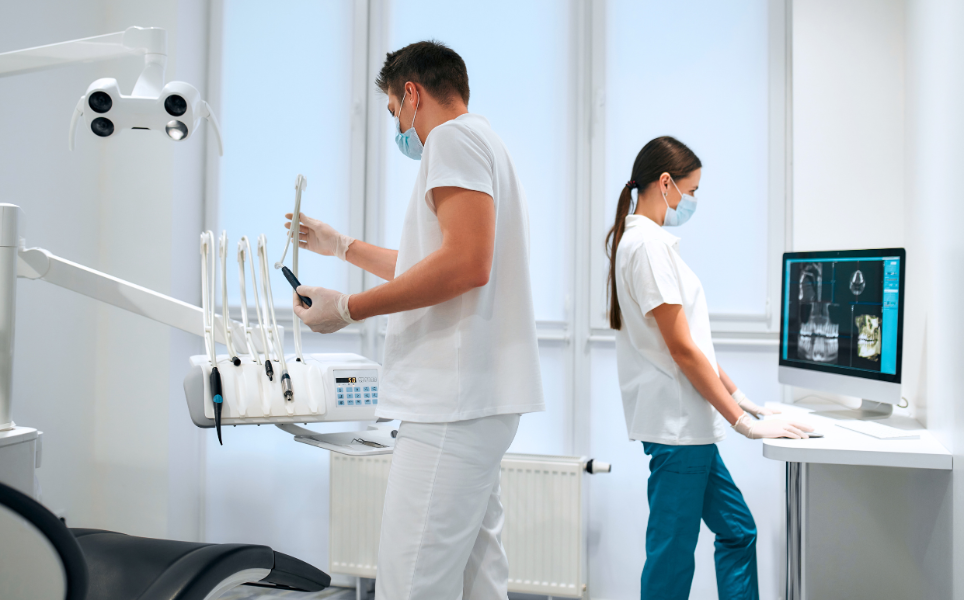Managing a dental practice is filled with responsibilities associated with running your office, from overseeing schedules and appointments to managing marketing spend. Installing a secure billing system, getting the right insurance coverage, and training your staff members all require diligent attention to ensure things run smoothly.
These many tasks can fill up the hours in your day, taking your time and attention away from providing the best possible dental care for your patients. However, a practice management system a dental software program will help you optimally manage your practice. Let’s explore how to run a dental practice management software comparison to ensure you secure the right solution for your practices.
What Does a Dental Practice Management System Do?
A dental practice management system (PMS) is a digital solution that helps track and optimise clinical and administrative processes, improving efficiency, profitability and the patient experience. The simplicity that comes with a centralised solution for managing daily tasks means dental professionals and supporting staff can achieve peak efficiency in their activities.
However, the definition and function of a PMS are changing in Australia. Shifting beyond basic scheduling and patient record-keeping roles, they have evolved into integrated digital platforms that support you with treatment planning, patient communications, data analysis and even financial forecasting. Technological advances, such as predictive AI, a demand for greater efficiency and an ongoing push for enhanced patient care are driving these changes.
What Are the Benefits of a Dental Practice Management System?
Implementing specialised dental practice management software is a must for any practice. Of course, not every product on the market is equal in its feature set, capabilities and ease of use. By carefully considering your choice, you can select a solution that combines all aspects of practice management.
Some of the benefits the right software can offer you are:
- Improved staff productivity: Consolidating patient data, communications, scheduling and more on one digital platform gives practitioners and administrative staff access to information when and where they need it. This reduces human error, allows everyone to make strategic decisions and ensures your team can perform their roles efficiently.
- Enhanced patient care: Simplified scheduling and automated patient communication tools bolster patient relationship management, while data analysis and clear information display help dental professionals make aligned, accurate treatment plan decisions during consultations.
- Optimised practice processes: Dental insights provides practices with the information they need to make evidence-backed decisions and transform their practice’s performance.
What Features Should You Look for During a Dental Practice Management Software Comparison?
Comparing and contrasting practice management software can be a long and tricky process if you begin without a plan. It pays to focus on a few key traits of each solution. The following are seven areas to inspect, each helping you select a tool that will empower your practice.
Feature Set and Functionality
This is the crux of why you are purchasing a dental practice management solution. You need a software tool that combines functionality from multiple areas of your business without skimping on quality in any of those areas.
Your chosen solution may offer some features by default while allowing you to add extra functionality through additional modules. The ideal selection for your practice will cover all your technology needs, meaning you won’t have to install multiple platforms. These features may include:
- Appointment scheduling and reminders: If all staff members have access to a real-time calendar tracking all appointments, planning each day becomes significantly easier. Further, a portal for making or changing online bookings is a key part of a user-friendly patient experience.
- Billing and financial management: Automated invoicing and real-time payment tracking lead to fewer errors, faster reimbursements and less time chasing overdue accounts. Digitally managed insurance claims can also expedite the process.
- Patient communication and engagement: Efficiently sending messages and reminders to patients reduces the chances of people missing appointments or cancelling at the last minute.
- Accurate and efficient clinical documentation: The ability to find patient records, clinical notes and internal documents is a valuable time-saver that can increase treatment accuracy. Many systems let you integrate scanned paper files or work entirely with digital content.
- Comprehensive charting tools: High-quality periodontal charting features, including 3D skull charting, allow health practitioners to create clear clinical notes. These visualisations help patients understand their treatment plans, which can encourage commitment.
- Data analysis and reporting: Generating reports from practice data is a great way to create strategies for more efficient, profitable operations.
- Cloud connectivity: Practice management systems based on the cloud (rather than on-premise) allow staff to access records, data and communications from multiple locations securely.
By comparing these features to your practice’s needs, you can select the ideal software tool to reach your goals.
Ease of Use and Efficiency
When practice management software is “clunky,” it can be difficult to convince employees to use it on a day-to-day basis, which can limit efficiency gains. Seek an intuitive option that combines a comprehensive feature set with a welcoming user interface. With integrated workflows to keep staff on the same page across every touchpoint, from booking to billing, eliminating the need to switch between systems or duplicate data entry.
Would mobile accessibility better support staff during peak hours or fast-paced days? Do lags or crashes currently interfere with productivity? Strive to get all stakeholders in the practice to weigh in. A dental practitioner’s needs and daily pressures will vary from those of your administrative staff. Receiving input from everyone will show you which solutions genuinely provide value — which can motivate staff to embrace the transition.
Further, dental management software that actually supports your workflow creates a more streamlined patient experience, which can boost positive online reviews and word-of-mouth recommendations.
Cloud-Based vs. On-Premise Options
While on-premise software solutions have long been a reliable way to keep dental operations on track, their cloud-based counterparts are increasingly surpassing them in the modern dental practice environment. Here are some points to consider as you decide which works best for your business:
- Maintenance and upgrades: Cloud-based dental software often updates automatically with no manual installs, whereas on-premise updates may need internal coordination and sometimes require downtime.
- Accessibility: Practitioners and admin staff can access cloud-based solutions from multiple locations and devices. Without installing additional systems, on-prem solutions are usually only accessible in the practice.
- Internet dependency: Localised software doesn’t always require internet access, whereas a cloud-based solution does. This may be an important consideration for smaller practices or those operating in remote areas.
- Scalability: Cloud systems easily scale as your practice grows, curbing the likelihood of hefty payments down the line. In-house software requires hardware upgrades as you scale, which may include big-ticket expenses.
- Backup and recovery: With automatic data backup, cloud integrations support faster recovery from tech glitches. On-prem usually requires time-consuming manual backups, posing extra risk in the event of power loss or physical damage.
- IT support: Cloud-based dental software requires less reliance on internal IT personnel. If you opt for an on-premise solution, you may need to factor in an IT contractor to manage your digital infrastructure.
Ultimately, cloud-based dental intelligence is leading the way for practices that value flexibility, security and opportunities to scale. That said, if you have limited internet accessibility or prefer to keep complete control over your IT environment, an on-premise solution might still make sense.
Pricing Models and Fee Structure
According to the Levin Group, dental practices should strive for 59% or less overhead. Saving on software — and building efficiency through its use — can help you control costs. When pondering the cost of a dental practice management software option, measure the price tag against the solution’s functionality. While digital solutions, in general, come with higher upfront costs than running your show manually, they pay dividends over the long term.
Check the upfront and ongoing costs for factors like licensing, hardware or software and maintenance. Certain products may also come with additional maintenance, security and data storage costs. Understanding the financial implications of good dental software will give you a better grasp of what you can achieve in the short and long term. Remember to allocate for what you stand to gain in increased productivity, including:
- Ongoing savings through reduced manual labour.
- Higher patient management efficiency, leading to more completed appointments.
- ROI from improved patient communication tools and fewer no-shows.
- The ability to scale without needing to rebuild your entire system.
Getting the best possible value for your budget means selecting the product that aligns with your practice’s needs — this might not be the most costly option on the market. That said, it is better to make a significant investment in a fully featured tool that will drive ROI than to miss out on key functionality.
Implementation, Training and Support Considerations
With all the specialised work you and your staff contribute daily, you shouldn’t need to become an overnight IT sensation to make it work. Ideally, dental practice management software should come with continued support and training from the developer. Equipping your team with the necessary knowledge and skills to hit the ground running will help you secure their support during the ramp-up, allowing you to start seeing the benefits as early as possible. Training and support are also important considerations for onboarding new staff as your practice grows.
Technical glitches and system downtime cut heavily into productivity and positive patient care outcomes. Ensure your chosen software provider is easily accessible by phone or online when a problem arises. The system will be the backbone of your practice, so patient support when and where you need it is essential for minimising practice disruptions.
Security and Compliance
As a medical practice, you manage patient files containing sensitive patient data. Your chosen practice management solution must meet the Australian Dental Association’s standards for data security to protect patient information and bolster your practice’s reputation management.
It’s not just about malicious activity: many security breaches stem from simple human errors, like weak passwords, sophisticated phishing or accidental data sharing. Dentistry IQ warns that a security-compromised business can lose 12% of its annual revenue dealing with the fallout. So, it’s worth considering how your software options handle security to mitigate risk. Consider the following:
- Data encryption: Patient data should be encrypted at rest and in transit. This prevents data theft during potential breaches or while syncing across devices.
- Role-based access controls: Dentists, hygienists and dental office staff should only have access to the information they need. Controlled access underpins professional accountability and integrity, protecting your patients, staff and practice.
- Compliance certifications: A reliable dental management software should clearly outline its adherence to healthcare-specific regulations and data privacy standards.
- End-to-end secure communications: Integrated patient communication tools should ensure messages sent to or from the platform are encrypted, secure and not leaked via email or SMS.
- Regular security updates: Reputable providers in the space will regularly issue updates to patch vulnerabilities. Cloud-based dental software should update automatically, whereas on-prem systems require manual updates.
- Secure connections with independent devices: Whether it’s printers, scanners, servers, mobile devices, clinical hardware, PCs or any other tech tool deployed in the office, inter-device connections should remain secure.
Recommendations and Peer Trust
Dental practices around the world face similar requirements and pressures. This means you can use word-of-mouth recommendations from peers to select a solution that fits your needs under real-world conditions. Explore whether fellow practice owners have previously switched programs and why — this can shine a light on overlooked red flags and potential pain points. Dive into their growth patterns to learn whether a solution is compatible with your current market position and direction.
Verified user reviews and case studies are great ways to gain insights into how a solution may positively impact your business. Another place to seek objective, experience-backed recommendations is through industry associates like the ADA or local dental boards.
Ready to Choose a Dental Practice Management Software?
Choosing the right dental practice management software means finding the right mix of features that aligns with your practice’s goals, workflows and growth plans. Whether your priorities lie in streamlining administrative tasks or improving patient care, the right platform should feel like a tool that works with you.
As you compare your options, keep in mind that the best-fit solution supports your team today while scaling with your practice. Dental4Web delivers a comprehensive, flexible and intuitive platform that performs across a range of practice sizes and environments.
See Dental4Web in Action
If you’re ready to simplify operations without compromising capability, book a demo to see how Dental4Web can work for you.





